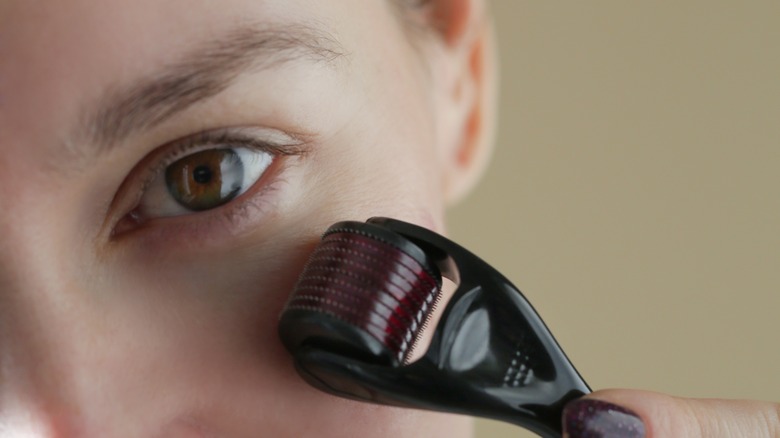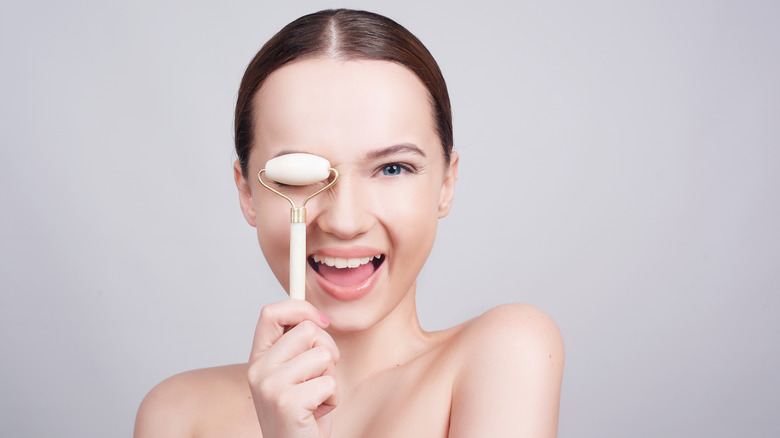Can Dermarolling Eliminate Dark Under-Eyes?
Fatigue, aging, and dermatitis can all cause dark under-eye circles, affecting your confidence and self-esteem. Unfortunately, this problem isn't always preventable and can stem from factors over which you have no control. For example, some people are genetically prone to dark circles, according to the Mayo Clinic. Others suffer from allergies, hay fever, or other issues that can affect the delicate skin around their eyes.
"Underneath the eye is a special pillow of soft tissue called the SOOF (suborbicularis oculi fat)," dermatologist Courtney Rubin, MD, explained to Byrdie. "Over time, this pillow of tissue shrinks and descends, leading to a decrease in the natural volume of the under-eye, and the creation of a shadow. This is one of the most common causes of dark circles." Cosmetic surgeon Reza Tirgari, MD, noted that underlying medical conditions and poor nutrition can also contribute.
Luckily, there are steps you can take to get rid of under-eye circles. One solution is dermarolling, or microneedling, a cosmetic procedure that can be performed at home. This treatment may not work for everyone, but you can give it a try before resorting to more invasive options.
The concept behind dermarolling
Dermarolling, a gentler version of microneedling, involves massaging your skin with a small device covered in hundreds of fine needles. Medical dermarollers feature needles of up to 1.5 millimeters in length, whereas those designed for home use have microneedles of 0.15 millimeters. The needle diameter may vary from one device to another, as a 2009 review published in the Journal of Cutaneous and Aesthetic Surgery notes.
This cosmetic procedure is said to rejuvenate the skin and reduce the appearance of wrinkles. Over time, it can also help minimize acne scars by increasing collagen and elastin production. At the same time, it increases the absorption of retinol, glycolic acid, and other topical drugs and skincare products into the skin, which may enhance their efficacy, according to clinical research presented in the journal Biomedical Microdevices.
Dermarolling doesn't hurt that much, but it may cause some discomfort and irritation. Its effectiveness depends on several factors, such as the needle size and type and the condition being treated. Home-use dermarollers may help shrink your pores, reduce excess sebum, and improve the appearance of fine lines. Perhaps not surprisingly, then, these handy tools could also help diminish dark circles and puffiness under the eyes.
Dermarolling can help with those pesky dark circles
Because microneedling stimulates collagen production, doing it on a regular basis may help improve skin appearance and firmness. Collagen loss is a normal part of aging and can contribute to dark circles forming. Therefore, this cosmetic procedure could improve the look of your under-eye area, per Healthline. At-home dermarolling isn't as effective as having it done by a professional, but it can still yield good results.
The microneedles on dermarollers create small tears in the skin, triggering an immune response. Basically, your body begins to release chemicals that facilitate healing and tissue repair. In the long run, this process can reduce skin inflammation and boost collagen synthesis, making your skin look firmer. In one study, published in the Indian Dermatology Online Journal, collagen production increased by a whopping 400% after just four microneedling sessions.
Dermarolling is generally well-tolerated and has minimal side effects. However, it may not be safe for people with keloid scars or those taking prescription medications for acne. Also, let your dermatologist know if you're having an acne breakout at the time of the procedure, per Healthline. As far as pricing goes, professional microneedling can cost up to $700 per session — and one treatment won't do it. By comparison, an at-home dermaroller costs considerably less.
How to use a dermaroller to treat dark under-eye circles
Dermarolling may or may not get rid of dark circles under the eyes, depending on what's causing them in the first place. For example, this procedure won't make much of a difference if your problem is due to an underlying condition or has genetic causes. But even so, it can still improve skin texture and minimize the signs of aging.
First things first, stay away from the sun and cosmetic injections for around three weeks prior to using your dermaroller, as medical aesthetician Nikki Anderson warned Fashion magazine. You'll also want to avoid topical acne treatments before the procedure, as they can be harsh on your skin. For best results, choose a device with needles measuring 0.1 to 0.3 millimeters in length and change the roller head at least once a month. You should also regularly clean it with rubbing alcohol and place it in a sanitary case after each use.
As a general rule, Byrdie recommends cleansing your face and applying a nourishing serum or primer before getting started. Then, press the device against your skin while rolling it up, down, and side-to-side. Avoid any areas with pimples, open wounds, or any other irritation. When you're done, apply a facial serum or cream to help your skin heal. Also, be aware that you may need to use a different type of needle for other conditions, such as enlarged pores, deep acne scars, or stretch marks.


